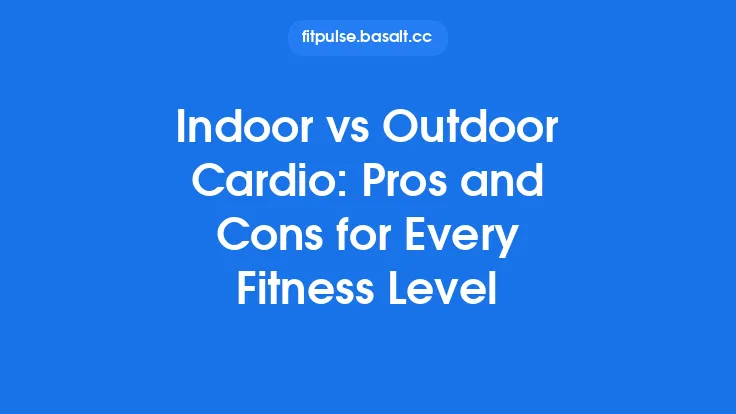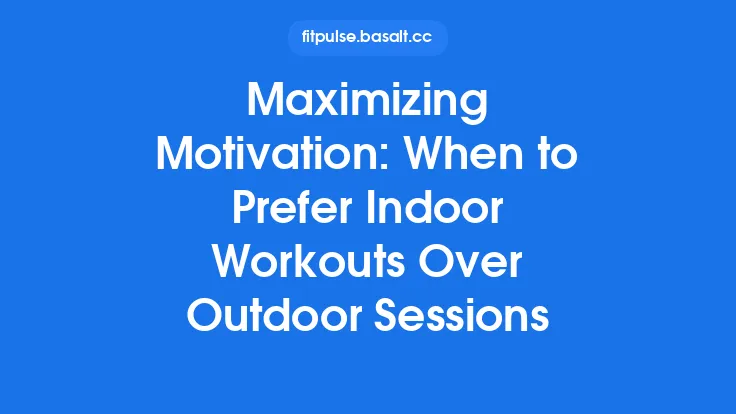Indoor cardio has long been viewed as a convenience‑driven alternative to stepping outside, but when the budget is the primary driver, the calculus becomes far more nuanced. Below is a deep dive into the economics of staying fit within four walls, measured against the often‑assumed “free” nature of outdoor cardio. By breaking down initial outlays, recurring costs, space considerations, and the true return on investment (ROI) in terms of calories burned and health benefits, you can make an informed decision that aligns with both your wallet and your cardiovascular goals.
Initial Investment: Equipment vs. No‑Equipment Options
| Option | Typical Up‑Front Cost | Typical Lifespan | Key Features | Approx. Cost per Minute of Use* |
|---|---|---|---|---|
| Running shoes (outdoor) | $80‑$150 | 300‑500 miles | Cushioning, stability | $0.27‑$0.50 |
| Basic treadmill (entry‑level) | $400‑$800 | 5‑10 years | Motor, belt, basic console | $0.10‑$0.20 |
| Folding treadmill (compact) | $250‑$500 | 3‑7 years | Space‑saving, lower motor power | $0.08‑$0.15 |
| Stationary bike (upright, basic) | $150‑$300 | 5‑8 years | Pedal resistance, simple LCD | $0.07‑$0.12 |
| Rowing machine (budget) | $250‑$500 | 5‑10 years | Full‑body cardio, water or magnetic resistance | $0.09‑$0.16 |
| Jump rope | $10‑$30 | 2‑5 years | Portable, high‑intensity | $0.02‑$0.05 |
| Staircase (home) | $0 (existing) | Indefinite | Weight‑bearing, interval‑friendly | $0.01‑$0.03 |
| Bodyweight circuits (burpees, high‑knees, etc.) | $0 | Indefinite | No equipment needed | $0.00‑$0.02 |
| Online cardio classes (subscription) | $10‑$30 / month | Ongoing | Variety, coaching | $0.03‑$0.07 per session |
\*Cost per minute is a rough average based on a 5‑year amortization period and typical usage of 150 minutes per week.
Key takeaways
- Zero‑equipment indoor cardio (jump rope, stair climbing, bodyweight intervals) can be dramatically cheaper than even the most basic machines.
- A modestly priced treadmill or bike quickly becomes cost‑effective when used consistently, especially if you factor in the higher wear‑and‑tear cost of outdoor shoes and occasional gear replacements.
- The “free” nature of outdoor running is deceptive; quality shoes, reflective gear, and occasional shoe replacement add up.
Recurring Expenses: Maintenance, Utilities, and Subscriptions
| Cost Category | Indoor Cardio | Outdoor Cardio |
|---|---|---|
| Electricity (average 1 kW motor, 1 hr/week) | $0.12 / week (≈ $6 / yr) | N/A |
| Equipment maintenance (belt, bearings, lubricants) | $20‑$40 / yr (treadmill) | N/A |
| Gym membership (if using commercial equipment) | $30‑$70 / mo | $0 (if running outside) |
| Footwear replacement (≈ $120 / yr) | $120 / yr (same shoes used outdoors) | $120 / yr |
| App/Streaming subscription | $10‑$30 / mo (optional) | $0‑$30 / mo (if using GPS or coaching apps) |
| Insurance (home equipment coverage) | $15‑$30 / yr (optional) | $0 (unless you have liability coverage for public spaces) |
Analysis
- Electricity is a minor line item; even a high‑intensity interval session on a treadmill consumes roughly the same power as a light household appliance.
- Maintenance for moving parts (treadmill belts, bike chains) is predictable and can be minimized with regular cleaning and occasional part replacement.
- Footwear remains the biggest shared expense. Investing in a durable pair of running shoes that can handle both indoor and outdoor surfaces can reduce the need for multiple pairs.
Space Utilization and Home Modifications
Cost‑effectiveness is not just about dollars; it’s also about the square footage you’re willing to allocate. Below are common indoor cardio solutions mapped to space requirements and potential modification costs.
| Solution | Minimum Floor Space | Ceiling Height | Typical Modification Cost |
|---|---|---|---|
| Jump rope | 6 ft × 6 ft | 8‑10 ft | $0 (clear a small area) |
| Staircase intervals | Existing stairs | N/A | $0 (use existing structure) |
| Bodyweight HIIT | 8 ft × 8 ft | 8‑10 ft | $0‑$50 (foam mat for floor protection) |
| Folding treadmill | 3 ft × 5 ft (folded) | 7‑8 ft | $0‑$100 (protective rug) |
| Upright bike | 2 ft × 4 ft | 7‑8 ft | $0‑$75 (bike mat) |
| Rowing machine | 2 ft × 8 ft (sliding) | 8‑9 ft | $0‑$100 (floor protector) |
Cost‑saving strategies
- Multipurpose furniture – A sturdy coffee table can double as a step platform for low‑impact cardio.
- Floor protection – Interlocking foam tiles are inexpensive (≈ $1‑$2 per tile) and protect both your floor and equipment.
- Vertical storage – Wall‑mounted racks keep a foldable treadmill or bike out of the way when not in use, preserving living space without extra cost.
DIY and Repurposed Solutions for Cardio
When budget constraints are tight, creativity can replace commercial equipment. Below are three proven DIY cardio setups, complete with material costs and performance estimates.
- PVC Pipe “Air‑Bike”
- Materials: 2 × 10 ft PVC pipe, 2 × 2 in. bicycle inner tube, 2 × carabiners, 1 × hand‑grip, sandbags for resistance.
- Cost: ≈ $25.
- Performance: Simulates upper‑body rowing; MET value ≈ 5.5 (moderate effort).
- Weighted Backpack Stair Climb
- Materials: Sturdy backpack, sand or water bottles (5‑10 lb total).
- Cost: $0‑$10 (if you already own a backpack).
- Performance: Adds 10‑15 % intensity to stair intervals; MET value rises from 8.0 to ≈ 9.0.
- Resistance‑Band “Ski‑Erg”
- Materials: Two heavy‑duty resistance bands, a sturdy door anchor, a wooden dowel (≈ 1 ft).
- Cost: $15‑$20.
- Performance: Mimics the pulling motion of a ski‑erg; MET ≈ 6.0 at vigorous effort.
These solutions provide comparable cardiovascular stimulus to commercial machines at a fraction of the price, while also being portable and easy to store.
Cost per Calorie Burn: Quantifying Efficiency
Understanding the monetary cost of each calorie burned helps translate abstract fitness goals into concrete budgeting terms. The calculation uses the following formula:
\[
\text{Cost per Calorie} = \frac{\text{Total Annual Cost}}{\text{Annual Calories Burned}}
\]
Assumptions for a typical user:
- Frequency: 4 sessions per week, 45 minutes each.
- Intensity: Moderate (≈ 7 METs for treadmill jogging, 8 METs for rowing, 5 METs for jump rope).
- Body weight: 70 kg (154 lb).
Sample calculations
| Activity | Annual Cost (incl. maintenance, electricity, gear) | METs | Calories per Session* | Annual Calories Burned | Cost per Calorie |
|---|---|---|---|---|---|
| Jump rope | $30 (rope + app) | 5 | 450 | 93,600 | $0.0003 |
| Stair climbing (home) | $20 (shoes) | 8 | 560 | 116,480 | $0.0002 |
| Folding treadmill (basic) | $150 (purchase amortized) + $30 (maintenance) + $6 (electricity) = $186 | 7 | 630 | 131,040 | $0.0014 |
| Upright bike (budget) | $200 (amortized) + $30 (maintenance) + $6 (electricity) = $236 | 6 | 540 | 112,320 | $0.0021 |
| Outdoor running (shoes only) | $120 (shoes) | 7 | 630 | 131,040 | $0.0009 |
\*Calories per session = MET × 3.5 × body weight (kg) ÷ 200 × duration (minutes).
Interpretation
- Zero‑equipment indoor options (jump rope, stairs) deliver the lowest cost per calorie, rivaling or beating outdoor running when shoe wear is accounted for.
- Entry‑level machines become cost‑effective only after sustained, high‑frequency use. If you fall below ~3 sessions per week, the cost per calorie rises sharply.
Long‑Term Value: Durability, Upgrade Paths, and Resale
When evaluating cost‑effectiveness, consider the lifespan and potential resale value of equipment.
| Equipment | Typical Warranty | Expected Lifespan | Resale Value (after 5 years) | Upgrade Flexibility |
|---|---|---|---|---|
| Jump rope | N/A | 2‑5 years (depends on material) | $5‑$10 (if high‑quality) | None |
| Folding treadmill | 1‑2 years (motor) | 5‑7 years | 30‑40 % of original price | Can add Bluetooth console |
| Upright bike | 1‑2 years (frame) | 6‑9 years | 35‑45 % | Interchangeable resistance modules |
| Rowing machine (magnetic) | 2 years (frame) | 8‑12 years | 40‑50 % | Add performance monitor |
| Staircase (home) | N/A | Indefinite | N/A | Can be repurposed as storage |
Strategic considerations
- Modular upgrades (e.g., adding a heart‑rate monitor to a bike) extend the useful life without a full replacement.
- Resale markets for used treadmills and bikes are robust on platforms like Craigslist and Facebook Marketplace, often recouping a sizable portion of the original cost.
- Durability of low‑tech options (rope, stairs) is essentially unlimited, making them the most “future‑proof” from a cost perspective.
Budgeting Strategies and Purchasing Tips
- Set a usage target – Calculate the minimum weekly minutes needed to achieve a break‑even cost per calorie. If you can’t commit to that volume, opt for cheaper alternatives.
- Shop off‑season – Treadmills and bikes often see price drops in late winter when demand wanes.
- Consider refurbished units – Certified refurbishments can shave 30‑50 % off MSRP while retaining warranty coverage.
- Leverage community resources – Some apartment complexes or co‑working spaces offer shared cardio equipment for a nominal monthly fee, effectively turning a large upfront cost into a small recurring expense.
- Bundle accessories – Purchasing a floor mat, heart‑rate monitor, and a set of resistance bands together often yields a discount compared to buying each item separately.
Comparative Summary: When Indoor Beats Outdoor on a Budget
| Scenario | Best Indoor Choice | Reason It Beats Outdoor |
|---|---|---|
| Limited space (studio apartment) | Jump rope + bodyweight HIIT | Near‑zero footprint, no need for shoes that wear out on pavement |
| Cold or inclement weather for > 4 months | Folding treadmill (basic) | Consistent indoor use spreads the amortized cost, avoiding seasonal shoe wear |
| Very tight budget (< $100) | Staircase intervals + weighted backpack | Utilizes existing architecture; only shoes and a backpack needed |
| Desire for full‑body cardio without extra equipment | Rowing machine (budget) | Higher MET value per minute reduces total time needed, offsetting higher purchase price |
| Preference for portable solutions (travelers) | Resistance‑band “ski‑erg” | Packs in a suitcase; cost per calorie remains low when used regularly |
In essence, the most cost‑effective indoor cardio solution aligns three variables: initial outlay, ongoing expense, and usage frequency. Zero‑equipment options dominate when usage is sporadic or space is at a premium, while modestly priced machines become advantageous for high‑frequency, long‑term cardio regimens. By quantifying both monetary and caloric returns, you can select an indoor cardio pathway that not only safeguards your heart but also respects your budget.





